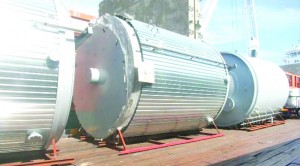
John Fernandes in Georgetown
Prime Minister Samuel Hinds, along with Guyana Power and Light (GPL) Chief Executive Officer Bharat Dindyal, on Friday visited the John Fernandes Wharf to inspect a US$ 32 million, five-component Wartsila generator set which is expected to be installed at the 26-megawatt Vreed-en-Hoop power station by next month-end, and become fully operational by April 2014.
The engines have a capacity of 8.6 megawatts each and will be contributing to the Demerara system, and eventually, Berbice and part of the East Bank Essequibo system, and will be moving from an 80-megawatt capacity to about 106 megawatts.
“There is where the money goes and what the money is required for, and this money in the first instance should come from the electricity bills that people pay over the period of time,” said Prime Minister Hinds.
Guyana has always had very good experiences with the Wartsila units.
With these new sets, power generation will be up from 5.5 to 8.7 megawatts, using heavy fuel oil; hence, the Amalia Falls Hydro Power Project is seen as critical to the future of the energy sector, the prime minister stated.
“This is why the Amalia project is needed,” Prime Minister Hinds stressed, and with all things taken into account including, fuel, capital investments and oil, the estimate will be about 23 cents per kilowatt per hour.”
GPL is looking to have electricity delivered at Sophia at 12 cents per kilowatt hour, and after 10 years, to about six cents. By then the cost of the Amaila Falls Hydro Power would have been paid off and generation down to two cents per hour.
Still hoping
He said that government is still hoping that the Amalia project would become a reality. “… I am not accepting that Amalia is not an immediate reality; I am going to go to the people of Guyana and I’m urging that we make it a referendum issue and go to the people of Guyana about it,” he added.
Reiterating that the issue is not a political one, but a question of getting power at a cheaper cost, the prime minister acknowledged that he was caught flat-footed with the opposition’s reluctance to the project because Amalia was identified during the People’s National Congress (PNC) administration in 1976 as one of the best sites to meet Guyana’s energy needs. This was also reinstated in another assessment in 1982.



